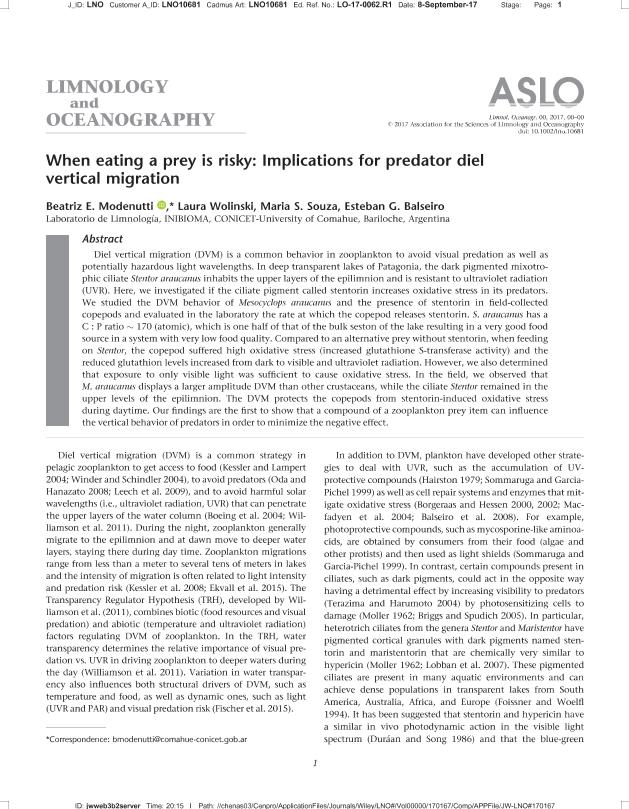Artículo
When eating a prey is risky: Implications for predator diel vertical migration
Fecha de publicación:
09/2017
Editorial:
Amer Soc Limnology Oceanography
Revista:
Limnology and Oceanography
ISSN:
0024-3590
Idioma:
Inglés
Tipo de recurso:
Artículo publicado
Clasificación temática:
Resumen
Diel vertical migration (DVM) is a common behavior in zooplankton to avoid visual predation as well as potentially hazardous light wavelengths. In deep transparent lakes of Patagonia, the dark pigmented mixotrophic ciliate Stentor araucanus inhabits the upper layers of the epilimnion and is resistant to ultraviolet radiation (UVR). Here, we investigated if the ciliate pigment called stentorin increases oxidative stress in its predators. We studied the DVM behavior of Mesocyclops araucanus and the presence of stentorin in field-collected copepods and evaluated in the laboratory the rate at which the copepod releases stentorin. S. araucanus has a C : P ratio ∼ 170 (atomic), which is one half of that of the bulk seston of the lake resulting in a very good food source in a system with very low food quality. Compared to an alternative prey without stentorin, when feeding on Stentor, the copepod suffered high oxidative stress (increased glutathione S-transferase activity) and the reduced glutathion levels increased from dark to visible and ultraviolet radiation. However, we also determined that exposure to only visible light was sufficient to cause oxidative stress. In the field, we observed that M. araucanus displays a larger amplitude DVM than other crustaceans, while the ciliate Stentor remained in the upper levels of the epilimnion. The DVM protects the copepods from stentorin-induced oxidative stress during daytime. Our findings are the first to show that a compound of a zooplankton prey item can influence the vertical behavior of predators in order to minimize the negative effect.
Palabras clave:
Antioxidants
,
Uvr
,
Ciliates
,
Predation
Archivos asociados
Licencia
Identificadores
Colecciones
Articulos(INIBIOMA)
Articulos de INST. DE INVEST.EN BIODIVERSIDAD Y MEDIOAMBIENTE
Articulos de INST. DE INVEST.EN BIODIVERSIDAD Y MEDIOAMBIENTE
Citación
Balseiro, Esteban Gabriel; Souza, María Sol; Wolinski, Laura Isabel; Modenutti, Beatriz Estela; When eating a prey is risky: Implications for predator diel vertical migration; Amer Soc Limnology Oceanography; Limnology and Oceanography; 9-2017; 1-12
Compartir




